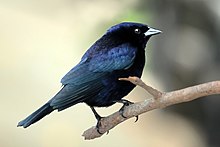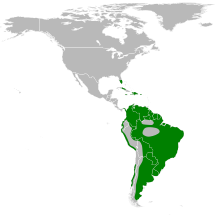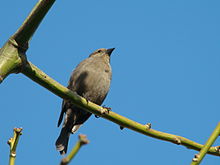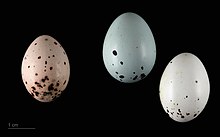
The cuckoo, common cuckoo, European cuckoo or Eurasian cuckoo is a member of the cuckoo order of birds, Cuculiformes, which includes the roadrunners, the anis and the coucals.

The brown-headed cowbird is a small, obligate brood parasitic icterid native to temperate and subtropical North America. It is a permanent resident in the southern parts of its range; northern birds migrate to the southern United States and Mexico in winter, returning to their summer habitat around March or April.

The yellow warbler is a New World warbler species. Yellow warblers are the most widespread species in the diverse genus Setophaga, breeding in almost the whole of North America, the Caribbean, and down to northern South America.

Brood parasitism is a subclass of parasitism and phenomenon and behavioural pattern of certain animals, brood parasites, that rely on others to raise their young. The strategy appears among birds, insects and fish. The brood parasite manipulates a host, either of the same or of another species, to raise its young as if it were its own, usually using egg mimicry, with eggs that resemble the host's.

The Carib grackle is a New World tropical blackbird, a resident breeder in the Lesser Antilles and northern South America east of the Andes, from Colombia east to Venezuela and northeastern Brazil. There are eight subspecies, of which the most widespread is the nominate subspecies of Trinidad and the South American mainland. This subspecies was introduced to Tobago in 1905 and is now common there.

Cowbirds are birds belonging to the genus Molothrus in the family Icteridae. They are of New World origin, and are obligate brood parasites, laying their eggs in the nests of other species.

The giant cowbird is a large passerine bird in the New World family Icteridae. It breeds from southern Mexico south to northern Argentina, and on Trinidad and Tobago. It may have relatively recently colonised the latter island. It is a brood parasite and lays its eggs in the nests of other birds.

The white-browed meadowlark is a passerine bird in the New World family Icteridae. It was formerly named white-browed blackbird but is not closely related to the red-winged blackbird group.

The bronzed cowbird, once known as the red-eyed cowbird, is a small icterid.

The chestnut sparrow is a species of passerine bird in the sparrow family Passeridae. It is the smallest member of the sparrow family, at about 11 cm (4.3 in) long. The breeding male has deep chestnut plumage and the female and juvenile are coloured a duller grey with some chestnut markings. Like its closest relatives in the genus Passer, the Arabian golden sparrow and the Sudan golden sparrow, it is gregarious and found in arid areas. Ranging through the east of Africa from Darfur in Sudan to Tanzania, it is found in dry savanna, papyrus swamps, and near human habitation. Adults and juveniles both feed mostly on grass seeds, and fly in flocks, often with other species of birds, to find food. It nests in trees, building its own domed nests, and also usurping the more elaborate nests of weavers.

Prevost's ground sparrow, also known as the white-faced ground sparrow, is an American sparrow.

The rufous-collared sparrow or Andean sparrow is an American sparrow found in a wide range of habitats, often near humans, from the extreme south-east of Mexico to Tierra del Fuego, and the island of Hispaniola in the Caribbean. It has diverse vocalizations, which have been intensely studied since the 1970s, particularly by Paul Handford and Stephen C. Lougheed (UWO), Fernando Nottebohm and Pablo Luis Tubaro (UBA). Local names for this bird include the Portuguese tico-tico, the Spanish copetón ("tufted") in Colombia, as well as chingolo and chincol, and comemaíz "corn eater" in Costa Rica.

The chalk-browed mockingbird is a bird in the family mimidae. It is found in Brazil, Bolivia, Argentina, Paraguay, Suriname, and Uruguay.

The grayish baywing, formerly known as the bay-winged cowbird, is a species of bird in the family Icteridae. It is currently placed in the genus Agelaioides but has traditionally been placed in the genus Molothrus. It is found in the northern half of Argentina, Bolivia, Uruguay, Paraguay and southern and central Brazil, The isolated population in north-eastern Brazil is usually now considered a separate species, the pale baywing. The greyish baywing has been recorded as a vagrant in Chile.

Forbes's blackbird is an endangered species of New World blackbird that is endemic to the Atlantic forest in South America. This species was named for the British zoologist William Alexander Forbes.

The screaming cowbird is an obligate brood parasite belonging to the family Icteridae and is found in South America. It is also known commonly as the short billed cowbird.

The green oropendola is a species of bird in the family Icteridae. It is found in wooded habitats in the Amazon basin and Guianas of South America, and is generally common. Uniquely among the oropendolas, the green oropendola has a pale bill with an orange tip. Male oropendola weigh around 400 grams, while females are in the 200 gram range. This is a common species and the International Union for Conservation of Nature has rated its status as being of "least concern".

The white-rumped swallow is a species of bird in the family Hirundinidae. First described and given its binomial name by French ornithologist Louis Pierre Vieillot in 1817, it was for many years considered a subspecies of the Chilean swallow. The species is monotypic with no known population variations. It has a white supraloral streak, or streak above its lores, which can be used to differentiate it from the Chilean swallow. The lores, ear coverts, tail, and wings are black, with white tips on the inner secondaries, tertials, and greater coverts of the wings. The rest of the upperparts are a glossy blue. Its underparts and underwing-coverts are white, in addition to the rump, as the name suggests. The sexes are similar, and the juvenile is duller and browner with a dusky breast.

Egg tossing or egg destruction is a behavior observed in some species of birds where one individual removes an egg from the communal nest. This is related to infanticide, where parents kill their own or other's offspring. Egg tossing is observed in avian species, most commonly females, who are involved with cooperative breeding or brood parasitism. Among colonial non-co-nesting birds, egg-tossing is observed to be performed by an individual of the same species, and, in the case of brood parasites, this behavior is done by either the same or different species. The behavior of egg tossing offers its advantages and disadvantages to both the actor and recipient.

























